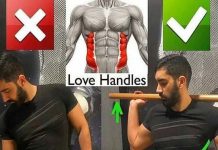🔥TRY THIS FULL CHEST WORKOUT💪
1️⃣ SMITH MACHINE PRESS
💥 The smith machine bench press is the same exact movement as the barbell bench press, with a few differences in how it engages your body. Smith machines can be found in most commercial gyms, and are simple pieces of equipment that only take a few seconds to learn how to use. They are designed to allow you to go heavy safely on exercises.
[wp_ad_camp_2]

✅ Remember the first con of barbell bench press? Safety first! The smith machine allows you to stop the bar upon failure with a flick of the wrist so it doesn’t come down on you. That means you can go heavy without a spotter and be at minimal risk of injury.
Stability is another big pro of the smith machine bench press. Since the bar on the smith machine is on a track, it can only move straight up and straight down. For learning the movement, this will help tremendously with form.
👇 HOW TO:
[wp_ad_camp_4]
- Place a flat bench underneath the smith machine. Now place the barbell at a height that you can reach when lying down and your arms are almost fully extended. Once the weight you need is selected, lie down on the flat bench. Using a pronated grip that is wider than shoulder width, unlock the bar from the rack and hold it straight over you with your arms locked. This will be your starting position.
- As you breathe in, come down slowly until you feel the bar on your middle chest.
- After a second pause, bring the bar back to the starting position as you breathe out and push the bar using your chest muscles. Lock your arms in the contracted position, hold for a second and then start coming down slowly again. Tip: It should take at least twice as long to go down than to come up.
- Repeat the movement for the prescribed amount of repetitions.
- When you are done, lock the bar back in the rack.
Caution: If you are new at this exercise, it is advised that you use a spotter. If no spotter is available, then be conservative with the amount of weight used.
2️⃣ DECLINE DB FLYES
[wp_ad_camp_1]

- Warm-up well, then choose 1-2 single-joint movements to start your chest workout. One movement is enough for most lifters. The second movement is for more advanced trainees who want an insane pre-exhaust.
- Take your working sets of pre-exhaust movements near muscle failure. Adjust your weights from set to set as needed depending on how many reps you reach.
- For the second part of the workout, choose several compound movements for chest from different bench angles. If you’re going to do dumbbells, do them earlier rather than later because of their difficulty to control. Adjust your poundage as necessary from set to set to reach the suggested target rep.
[wp_ad_camp_5]
- A spotter is recommended on your multijoint exercises, because your strength is compromised. Consider machine movements toward the end of your chest workout to better control the weight.
- Follow this type of training for no more than about six weeks before returning to a more conventional style of training. Or, you can do this kind of workout infrequently for a change of pace.
- The following workout follows a basic pyramid structure, but it can be set up in other ways as well.
- Make exercise substitutions based on personal preferences or to target weaknesses.
3️⃣ DB BENCH PRESS
















































